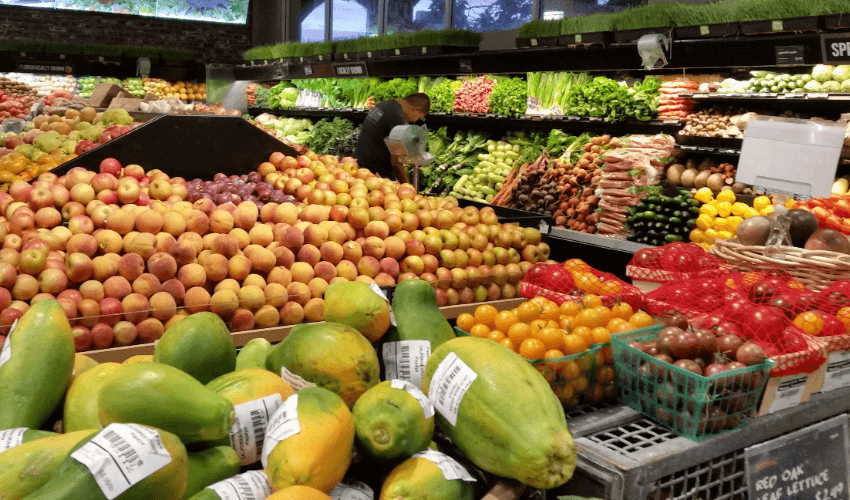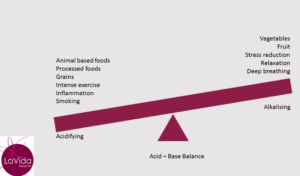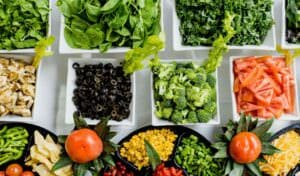Tips for saving shopping time and improving your nutrition
Have you ever done this? Rushed into the supermarket, not sure what you need, grabbed a few items and rushed out. I know I have! But what if this is you on a regular basis? What are the consequences of this? Over time it results in increased consumption of packaged or pre-prepared foods. Or maybe, you end up in a “food rut”, eating the same foods week in, week out. Sound familiar? Mealtimes become a bit boring and/or your meals are heavy on salt, sugar, preservatives and other hidden ingredients which aren’t great for your health.
It would be lovely to think we can casually stroll around our nearest market, selecting beautiful produce (like they do on those TV shows), but that’s not my world.
If you are like me, you don’t have the brain-power to work out a meal plan while you are in the shop at the end of a busy day…and those brightly coloured, pre-prepared foods with the great photos on the front look very appealing.
The reality is we are busy and shopping for food is just another job on our “to do” list. Unfortunately this may not be good for your short or long term health. So, here’s what I have learnt to do.
3 winning tips for making grocery shopping quick and healthy
- Set aside 10-15 minutes each week to do a meal plan. That’s all the time you need to think about breakfasts, lunches, dinners and snacks. If you want to study recipe books it might take a bit longer but otherwise 10 minutes should do it. It’s really worth it. Think about the time it will save you during the week not having to think about every meal with the same old “what will we have for dinner tonight?” problem. Doing this also increases your likelihood of having balance and variety in your meals, therefore your nutrition improves! If you’re an omnivore, aim to get some vegetarian meals in there along with some seafood to balance out your meat. If you are a vegetarian it’s even more important that you plan your meals to ensure you are getting all the vital nutrients you need.
- Always make a shopping list. It avoids the need to wander around the supermarket therefore saves time and reducing the chance of being tempted by foods you probably don’t need or want. (It’s in my nature to organise my list by aisle/category which saves even more time…but maybe that’s just me).
- Try to avoid food shopping when hungry (not always possible I know but if you have a list that will help enormously).
4 more tips to go even further
- Stick to the outside aisles of the supermarket. This is usually where the fruit, vegetables, meat, fish and other fresh food are kept. These are the items which hopefully constitute the bulk of your basket. If you are lucky you can do a whole shop without venturing into those centre aisles full of processed “foods”.
- Only venture into the centre aisles to get specific things on your list like toilet paper, pet food etc. This helps to avoid temptation. (And have you noticed how they always put all kinds of heavily discounted junk food on the highly visible ends of aisles…walk straight past them).
- Look at the amount of GST on your bill. The lower it is, the “healthier” your shopping basket! (Maybe you can even get out of a supermarket paying nothing in GST).
- For those inevitable items you will buy in packets, learn to read nutritional panels.
Learning to read nutrition panels and labels…what to look for and what to ignore.
Have you stopped to look at the ingredient list or salt (sodium) or sugar content of your favourite biscuit or breakfast cereal? It can be alarming! Learning to pick options that are better for your needs is a skill that will serve you well.
Start with these tips:
- Ignore all the “hype” on the front or back of the packet. Remember, it is just marketing. It’s bright, colourful and designed to be persuasive. The bigger and bolder the hype the more suspicious you should be. Just because something says it’s “cholesterol free” or “low fat” or some other “health claim” doesn’t automatically mean it’s healthy. Potato chips are cholesterol free but that doesn’t mean they are healthy. They are high in salt and fat which may not be what you need. Fruit and vegetables generally don’t come in bright packets with lots of health claims but they are some of the most nutritious foods you will find in the supermarket.
- Learn to look at the ingredients list. Ingredients are listed in order of quantity from highest to lowest. So, think about what you would expect to find in that particular food and then look at the ingredients. Where do your expected ingredients appear? They should be the first ones. (How many times have you looked at a packet saying it contains “blueberries” or similar healthy food only to find they are the last ingredient…they’ve practically been waved over the packet!)
- The more ingredients in a food, generally the more processed it is. So, look for options with fewer ingredients.
- Be wary of ingredients lists that contain lots of numbers (additives, flavourings, colourings, preservatives etc.) or words you can’t pronounce that sound like they came out of a laboratory.
- Be wary of hidden sugars. Ingredients that end in “ose” such as glucose, sucrose, fructose and maltose are all forms of sugar. Also ingredients ending in “ol” like mannitol or sorbitol. Sometimes sugar sneaks in, in disguise.
- Learn to read nutrition panels and compare products. Make sure you are comparing the same size measure (e.g. per 100gms). Don’t just look at kilojoules. Consider fibre content (higher is better), sodium (salt) content (lower is better), sugar content, protein, saturated fat and total fat. It can get very confusing, trying to compare and make a decision. Your particular choice will depend on your own health needs and may be different to someone else’s. You might be focusing on lower salt whereas someone else might be trying to boost their fibre. But don’t give up. It will be worth it, and you will learn a lot for the benefit of your long term health.
I have more tips on healthy eating here.
Practise makes perfect
There’s no need to get technical and you don’t need a science degree. Just keep it simple. You might find you take a little longer to do your shopping initially as you spend some time comparing cereals, breads, crackers etc until you find the ones that will suit you best. to make it easier, you can do your research online if you prefer or maybe just pick one food to focus on first (eg bread). The time you save by having a meal plan and a shopping list will compensate for this research time. You’ll find the variety of what you eat improves and the stress of wondering what to eat decreases. And chances are your health will improve too!





